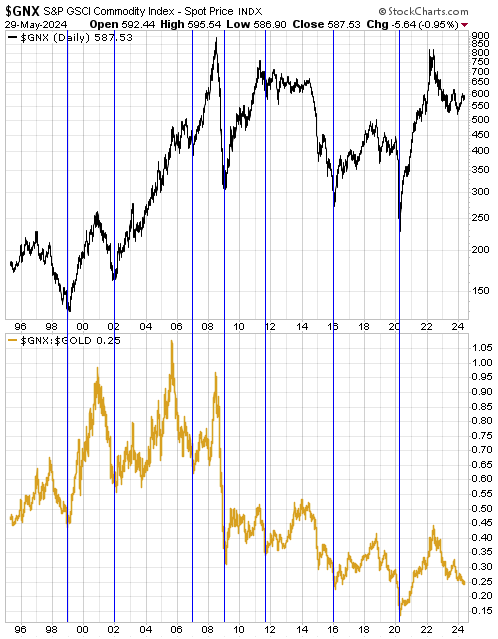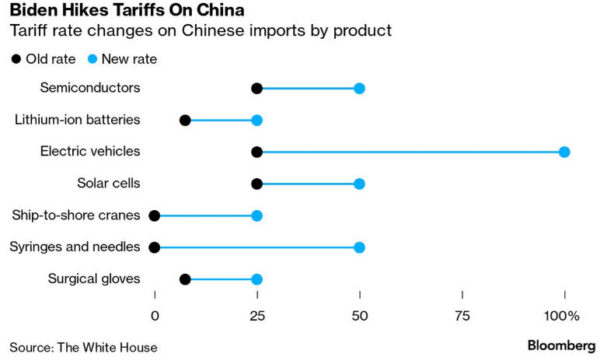[This blog post is an excerpt from a recent commentary published at www.speculative-investor.com]
Gold is no longer money in the true meaning of the word*, but it still trades more like a currency than a consumable commodity and therefore should be analysed as a currency. In fact, in a currency hierarchy we would put gold at the top, then the US$, then a big drop to the euro, then another big drop the other major currencies. Consequently, it makes sense to analyse markets in gold terms as well as in terms of the US$ and other currencies, which is something we do regularly. For example, we pay close attention to the performances of the S&P500 Index (SPX) and the Spot Commodity Index (GNX) in gold terms. Now we are going to look at one aspect of the relationship between commodity prices in US$ terms and commodity prices in gold terms.
The following chart compares the general level of commodity prices in US$ terms (as represented by GNX) with the general level of commodity prices in gold terms (as represented by the GNX/gold ratio). The point we want to highlight today is that since 1995, GNX has made cycle lows in US$ terms and gold terms at the same time. These important lows are indicated by the vertical blue lines drawn on the chart.

Each of the lows in GNX and GNX/gold indicated by the vertical blue lines coincided with a recession and/or some form of debt crisis. Specifically, the April-2020 low coincided with the COVID crisis/recession, the January-2016 low coincided with the climax of the debt crisis in the US shale-oil sector, the late-2011 low coincided with the euro-zone sovereign debt crisis, the early-2009 low coincided with the climax of the Global Financial Crisis, the January-2007 low coincided with the climax of the initial phase of the US housing/mortgage bust, the early-2002 low coincided with the collapse of the dot.com equity bubble and the end of the 2001 recession, and the late-1998 low coincided with the climax of the Russian debt crisis and LTCM blow-up.
If past is prologue, then GNX won’t bottom in US$ terms until it has bottomed in gold terms. So, has GNX bottomed relative to gold?
As mentioned above, in the past the GNX/gold ratio has bottomed in parallel with a recession and/or some form of debt crisis, both of which are likely outcomes within the next 12 months but neither of which has happened during the current cycle. Therefore, there’s a good chance that the bottom for GNX still lies ahead and that the recent commodity rally is a countertrend move within an on-going cyclical decline.
*Money is defined by its function, not its physical characteristics. It is the general medium of exchange or a very commonly used medium of exchange within an economy. This means that if something is money it will be readily accepted by almost everybody in payment for goods, services, debts and assets. Other definitions have been concocted in an attempt to make the case that gold is still money, but all of these definitions are impractical.
 Print This Post
Print This Post

